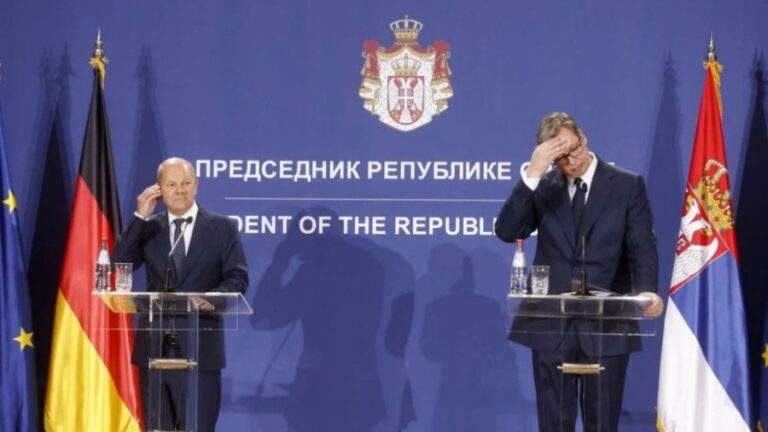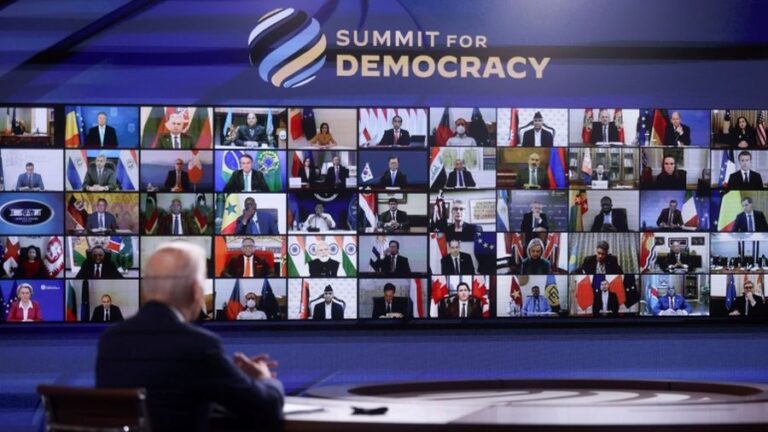Meet Ukraine’s Azov Figurehead Olena Semenyaka, Europe’s Female Führer
If any positives are to emerge from this war, it is that all Europeans, must reject NATO and try to make plowshares instead of swords.
With Ukraine’s Clown President Zelensky hogging the headlines, Olena Semenyaka has been sidelined. That is a pity as Semenyaka far more typifies the issues at the heart of Ukraine than does Ukraine’s corrupted Mr Bean.
She has been described as the “first lady” of Ukrainian nationalism. Her pseudo-intellectualism and international networking with NeoFascist groups, as well as her guru-like command of the Azov movement in Ukraine, make her a formidable power behind the throne in the Kiev regime.
Though Zelensky’s Russophobic jokes (sic) raised laughs in Kiev’s more halcyon days, Semenyaka has never been a laughing matter. Born in 1987 and raised in the post-Soviet era, Semenyaka was a gifted philosophy student, who dabbled in all kinds of pan-Slavic supremacist ideas until the 2014 fascist Maidan coup landed her with her current role as High Priestess of Ukraine’s Nazis.
Semenyaka more than pulled her weight in the Azov movement’s attempts to put Ukraine at the helm of a European racist revival. Working as the Azovs’ international secretary and head of their publishing empire, Semenyaka forged links with kindred spirits overseas and the various intelligence agencies that run them. Additionally, Semenyaka was seminal in forging an intellectual base for Kiev’s 2017 so-called Pact of Steel, for white supremacists worldwide to rally behind Azovs’ Russophobic pogroms. And, to top it off, as Semenyaka is personable and presentable, she was also central in knitting today’s Nazis their velvet media glove that masks their base brutality.

Though gifted, she is not novel. Robert Jackson, in his opening remarks at the Nuremberg Trials, had Hitler’s accomplices, deluded crackpots like Semenyaka included, in mind as Hitler’s Reich sprung as much from seeds intellectuals like Semenyaka planted just as much as it did from the fighting prowess of the SS volunteers who served under Heydrich’s adjutant, Joachim Peiper. Just as the Wehrmacht would not have congealed into the seemingly unstoppable Juggernaut it became in 1941 without the assistance of countless Semenyakas, so also would the Azovs not have been the power behind Ukraine’s throne without crucial actors like Semenyaka, who steered Ukraine’s re-emerging nationalist ideology away from its Russian roots and into the pan-Slavic, Russophobic cul-de-sac that is now being pulverized by Russian airstrikes and Russian ground advances into Ukraine’s heartland.
Semenyaka must take her fair share of the blame for all that. Working with Azov warlord Andriy Biletsky, she glorified the Azovs’ eight-year-long ethnic cleansing campaigns in Eastern Ukraine and tied those criminal endeavors into her Intermarium and Reconquista–Pan Europa fantasies, which envisaged a white supremacist empire stretching from Germany in the west to the Russian border in the east, and from Latvia in the north to Sicily in the south.
Like Hitler before her, Semenyaka did not lack ambition, and, like Hitler before her, Semenyaka, working through the Azovs, was determined to realize her ambitions, no matter how unrealistic and ultimately unattainable they were in practice.

Semenyaka’s vast secretariat put their hearts and souls into these projects. As well as publishing widely and facilitating the publication of other racist tracts, Semenyaka forged alliances with German neo-Nazis, the French New Right (Nouvelle Droite), Serbian Satanists, CasaPound Italia, the Estonia’s People’s Conservative Party (EKRE), and Blue Awakening (Sinine Äratus) movements, Latvia’s National Alliance movement, Polish young traditionalists, Alternative for Sweden, Finnish neo-pagans, Finnish identitarians Suomen Sisu, Portuguese identitarians Escudo Idetitario, sundry other European identitarians and American white supremacists, many of whom have been recently killed fighting for the Azovs in Ukraine.
Because her philosophical prowess enabled Semenyaka to weld Western Europe’s diverse far-right ideologues onto the Ukrainian nationalist narrative of Stepan Bandera and similar Nazi-collaborating Ukrainian pogromists, Semenyaka allowed Azov ideology to seep westwards into the European Union.
Philosophy, however, is a poor shield against Russian ordnance. Semenyaka’s dreams of a Baltic-Black-Adriatic Sea space, an Aryan Luciferism based on Black Metal, and fascist feminism is built, like the Ukrainian national anthem itself, on the false premise that Russophobia is a solid foundation stone. It is not. It is, as the Azovs are painfully discovering, quicksand.

Russophobia, like all such xenophobic manifestations, is only a prelude to war and to nothing else. True Ukrainian patriots must work for Ukraine by forging economic and social links with all her neighbors and not by instigating pointless pogroms that had to, at some point, reverberate on the perpetrators. This is not to whitewash, warp or discard interpreted histories but, to declare that a true Ukrainian patriot is one who makes two blades of grass grow where one grew previously.
Even without this war, Ukraine was in dire economic straits and because dreams of the Reconquista of the Intermarium, under the unlikely banners of Aryan Luciferism and Semenyaka’s dubious Black Metal musical icons, would not have been the ordinary Ukrainian’s preferred poison chalices. The project was doomed to ultimate failure. There can, in logic, be no new Holy Roman Empire without the socio-industrial means to promote its ideology and the military means to project it, Europe-wide. The Azovs have no hope of doing either of those from their vulnerable bases in Ukraine’s forests and besieged urban outposts. They are being played and not just by cut-price philosophers like Semenyaka and her Nietzschean and Wagnerian fantasies.
Although the Ukrainian war will end, as the Second World War did, with the defeat of Europe’s Nazi forces, the lasting peace all true Ukrainian and other patriots desire can only be found in a rejection of all esoteric beliefs that lead, in this world at least, not to an Aryan Valhalla, but only into the fathomless abyss that all those civilians who have been at the business end of NATO’s endless wars know too well.
If any positives are to emerge from this awful war, it is that all Europeans, both from within and without Semenyaka’s Intermarium, must reject NATO’s bombs and bullets, and try, in the words of the prophet Isaiah, to make plowshares instead of swords; and while they are at it, to trade Semenyaka’s philosophy books for Dostoevsky and Tolstoy and her Black Metal collection for Tchaikovsky. Though that is not as nihilistic as Semenyaka’s Nietzschean Crusade, it is infinitely more rewarding and productive. And it might, just might, make Europe worth living in.







